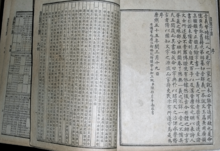Kangxi Dictionary
| Kangxi Dictionary | |||||||||||||||||||||||

The Kangxi Dictionary: 2005 reprint
|
|||||||||||||||||||||||
 |
|||||||||||||||||||||||
| Chinese name | |||||||||||||||||||||||
|---|---|---|---|---|---|---|---|---|---|---|---|---|---|---|---|---|---|---|---|---|---|---|---|
| Chinese | 康熙字典 | ||||||||||||||||||||||
|
|||||||||||||||||||||||
| Vietnamese name | |||||||||||||||||||||||
| Vietnamese alphabet | Khang Hi tự điển | ||||||||||||||||||||||
| Hán-Nôm | 康熙字典 | ||||||||||||||||||||||
| Korean name | |||||||||||||||||||||||
| Hangul | 강희자전 | ||||||||||||||||||||||
| Hanja | 康熙字典 | ||||||||||||||||||||||
|
|||||||||||||||||||||||
| Japanese name | |||||||||||||||||||||||
| Kanji | 康熙字典 | ||||||||||||||||||||||
| Hiragana | こうきじてん | ||||||||||||||||||||||
|
|||||||||||||||||||||||
| Transcriptions | |
|---|---|
| Standard Mandarin | |
| Hanyu Pinyin | Kāngxī Zìdiǎn |
| Wade–Giles | K'ang-hsi Tzu-tien |
| Wu | |
| Romanization | Khan平si入 Zy去di平 |
| Yue: Cantonese | |
| Yale Romanization | Hōnghēi Jihdín |
| Jyutping | Hong1 hei1 zi6 din2 |
| Southern Min | |
| Hokkien POJ | Khong-hi Jī-tián |
| Transcriptions | |
|---|---|
| Revised Romanization | Ganghui Jajeon |
| McCune–Reischauer | Kanghŭi Chajŏn |
| Transcriptions | |
|---|---|
| Revised Hepburn | Kōki Jiten |
The Kangxi Dictionary (Chinese: 康熙字典; pinyin: Kāngxī Zìdiǎn) was the standard Chinese dictionary during the 18th and 19th centuries. The Kangxi Emperor of the Manchu Qing Dynasty ordered its compilation in 1710. It used the earlier Zihui system of 214 radicals, today known as 214 Kangxi radicals, and was published in 1716. The dictionary is named after the Emperor's era name.
The dictionary contains more than 47,000 characters, though some 40% of them are graphic variants. In addition, there are rare or archaic characters, some which had been attested only once. Less than a quarter of these characters are now in common use.
The Kangxi Dictionary editors, including Zhang Yushu (張玉書) and Chen Tingjing (陳廷敬), based it partly on two Ming Dynasty dictionaries: the 1615 Zihui (字彙 "Character Collection") by Mei Yingzuo (梅膺祚), and the 1627 Zhengzitong (正字通 "Correct Character Mastery") by Zhang Zilie (張自烈). Since the imperial edict required that the Kangxi Dictionary be compiled within five years, a number of errors were inevitable. The Daoguang Emperor established a review board and their 1831 Zidian kaozheng (字典考證 "Character Dictionary Textual Research") corrected 2,588 mistakes, mostly in quotations and citations.
The supplemented dictionary contains 47,035 character entries, plus 1,995 graphic variants, giving a total of 49,030 different characters. They are grouped under the 214 radicals and arranged by the number of additional strokes in the character. Although these 214 radicals were first used in the Zihui, due to the popularity of the Kangxi Dictionary they are known as Kangxi radicals and remain in modern usage as a method to categorize traditional Chinese characters.
...
Wikipedia
